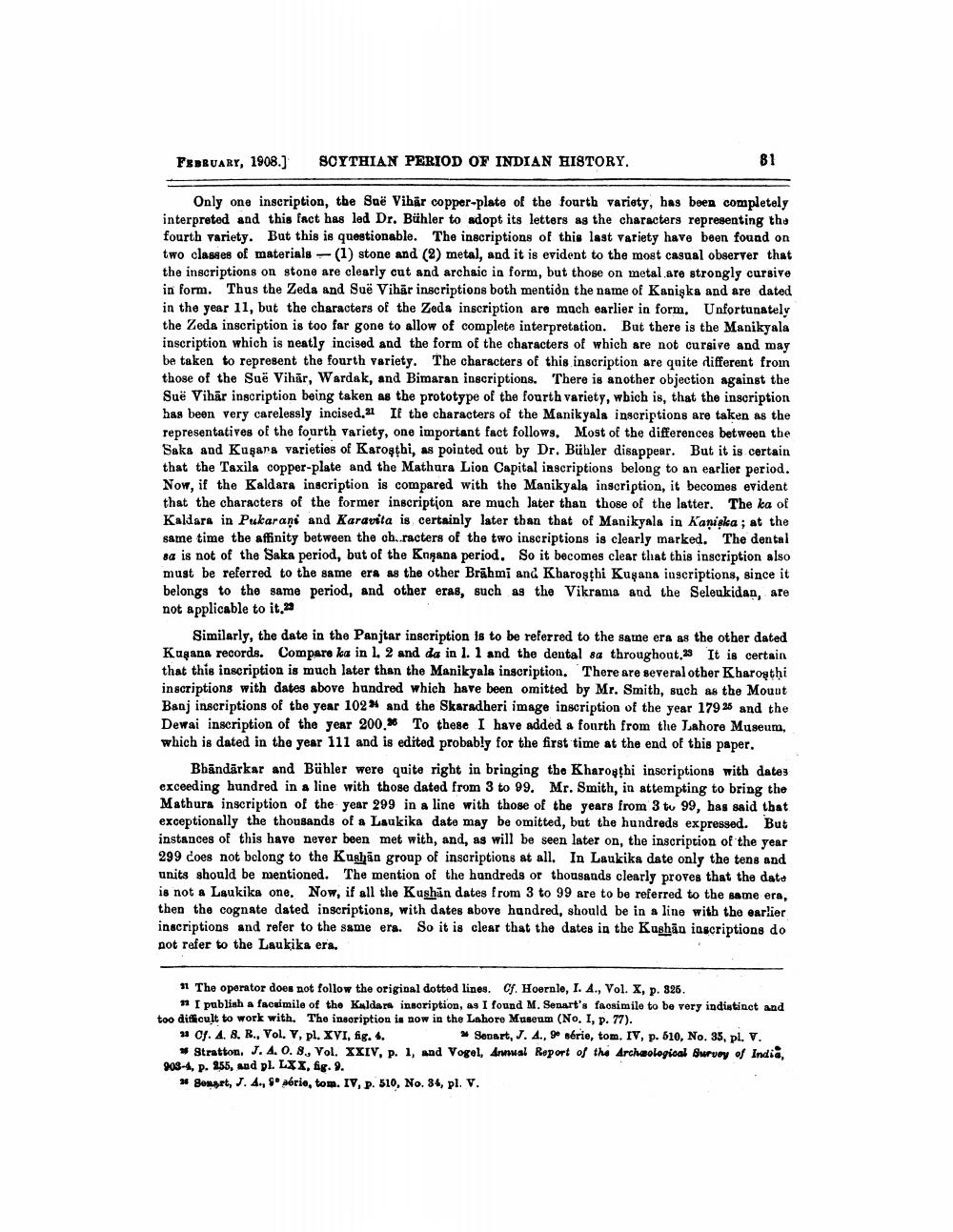________________
FEBRUARY, 1908.] SCYTHIAN PERIOD OF INDIAN HISTORY.
Only one inscription, the Suë Vihar copper-plate of the fourth variety, has been completely interpreted and this fact has led Dr. Bühler to adopt its letters as the characters representing the fourth variety. But this is questionable. The inscriptions of this last variety have been found on two classes of materials (1) stone and (2) metal, and it is evident to the most casual observer that the inscriptions on stone are clearly cut and archaic in form, but those on metal are strongly cursive in form. Thus the Zeda and Sue Vihar inscriptions both mention the name of Kanişka and are dated in the year 11, but the characters of the Zeda inscription are much earlier in form. Unfortunately the Zeda inscription is too far gone to allow of complete interpretation. But there is the Manikyala inscription which is neatly incised and the form of the characters of which are not cursive and may be taken to represent the fourth variety. The characters of this inscription are quite different from those of the Suë Vihar, Wardak, and Bimaran inscriptions. There is another objection against the Suë Vihar inscription being taken as the prototype of the fourth variety, which is, that the inscription has been very carelessly incised. If the characters of the Manikyala inscriptions are taken as the representatives of the fourth variety, one important fact follows. Most of the differences between the Saka and Kugana varieties of Karosthi, as pointed out by Dr. Bühler disappear. But it is certain that the Taxila copper-plate and the Mathura Lion Capital inscriptions belong to an earlier period. Now, if the Kaldara inscription is compared with the Manikyala inscription, it becomes evident that the characters of the former inscription are much later than those of the latter. The ka of Kaldara in Pukarani and Karavita is certainly later than that of Manikyala in Kaniska; at the same time the affinity between the ch..racters of the two inscriptions is clearly marked. The dental sa is not of the Saka period, but of the Kngana period. So it becomes clear that this inscription also must be referred to the same era as the other Brahmi and Kharosthi Kusana inscriptions, since it belongs to the same period, and other eras, such as the Vikrama and the Seleukidan, are not applicable to it,29
81
Similarly, the date in the Panjtar inscription is to be referred to the same era as the other dated Kugana records. Compare ka in 1, 2 and da in 1. 1 and the dental sa throughout.23 It is certain that this inscription is much later than the Manikyala inscription. There are several other Kharosthi inscriptions with dates above hundred which have been omitted by Mr. Smith, such as the Mount Banj inscriptions of the year 102 and the Skaradheri image inscription of the year 17925 and the Dewai inscription of the year 200. To these I have added a fourth from the Lahore Museum, which is dated in the year 111 and is edited probably for the first time at the end of this paper.
Bhandarkar and Bühler were quite right in bringing the Kharosthi inscriptions with dates exceeding hundred in a line with those dated from 3 to 99. Mr. Smith, in attempting to bring the Mathura inscription of the year 299 in a line with those of the years from 3 to 99, has said that exceptionally the thousands of a Laukika date may be omitted, but the hundreds expressed. But instances of this have never been met with, and, as will be seen later on, the inscription of the year 299 does not belong to the Kushan group of inscriptions at all. In Laukika date only the tens and units should be mentioned. The mention of the hundreds or thousands clearly proves that the date is not a Laukika one. Now, if all the Kushin dates from 3 to 99 are to be referred to the same era, then the cognate dated inscriptions, with dates above hundred, should be in a line with the earlier inscriptions and refer to the same era. So it is clear that the dates in the Kushan inscriptions do not refer to the Laukika era.
11 The operator does not follow the original dotted lines. Cf. Hoernle, I. A., Vol. X, p. 326.
"I publish a facsimile of the Kaldara inscription, as I found M. Senart's facsimile to be very indistinct and too difficult to work with. The inscription is now in the Lahore Museum (No. I, p. 77).
23 Cf. A. 8. R., Vol. V, pl. XVI, fig. 4.
Senart, J. A., 9e série, tom. IV, p. 510, No. 35, pl. V. Stratton, J. A. O. 8., Vol. XXIV, p. 1, and Vogel, Annual Report of the Archeological Survey of India, 903-4, p. 255, and pl. LXX, fig. 9.
2 Sonart, J. A., 9° aórie, tom. IV, p. 510, No. 34, pl. V.




